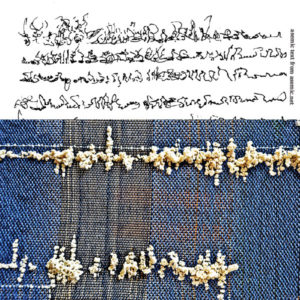 Get your translation skills ready by weaving asemic writing. Asemic writing doesn’t have any meaning except for that which invites the ‘reader’ to interpret their own. It’s an excuse to be creative with line and Saori weaving is the perfect free style to work with.
Get your translation skills ready by weaving asemic writing. Asemic writing doesn’t have any meaning except for that which invites the ‘reader’ to interpret their own. It’s an excuse to be creative with line and Saori weaving is the perfect free style to work with.
I’ve always been interested in texts – writing, calligraphy, typography. Adding and designing fonts for the computer and largely admiring the skills of people who have designed fonts. We see them everyday and usually don’t look into who designed them and what they were trying to achieve.
Many artists have been inspired by asemic writing and its followers create artworks in many mediums. If you do an image search on asemic writing you will come up with lots of examples and inspiration. The weaving shown here was a heavily textured yarn intermittently threaded into the warp as a supplement, as I was weaving. This means winding a bobbin of the supplement warp yarn then selecting one warp thread in which the thread on the bobbin follows exactly through the heddle eye and the reed and then is woven into the cloth so the new thread can begin its journey. THe bobbin can be used as a weight at the back of the loom with a slip knot or just have it lying on the floor. I have thought about asemic writing alot and wove the piece as a demo in this weekend’s workshop but then found the written illustration which sort of looked the same!
Techniques to do this can be 3 colour clasped weft, woven shibori, block floats, Mt Fuji technique in a smaller area… and on and on. I’m placing this challenge up on Australian Saori Curiousweaver Ravelry group too, for all to join in.
See here a new video on how to weave the clasped weft with three colours. There are a couple of methods of weaving with three colours and this is the one which requires more in the set up of the first row. Another idea for creating liney type shapes in a calligraphic style.
